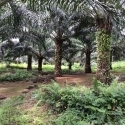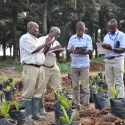14 Mar 2018
Oil Palm Yield Intensification Ghana
IPNI project in Ghana is successfully supporting plantations and smallholder producers to increase yields through best management practices.
 Oil Palm Nursery
Oil Palm Nursery
The Future Development of the Oil Palm in Ghana: Area Expansion or Yield Intensification
Palm oil is an edible vegetable oil that is a common cooking ingredient in Southeast Asia, Africa and parts of Latin America. The increased demand for palm oil is due to its growing popularity in the commercial food industry.
Oil palm expansion over the last decade in West Africa is fuelled by this global demand. Cultivation of oil palm is widespread in the West African region although the average annual yields remain small and sub-optimal at a production of less than 4 tonnes of fresh fruit bunches per hectare compared with the potential annual yield of approximately 25 tonnes per hectare.
This case study on oil palm cultivation in Ghana maps the country into 4 climatic zones defined according to their mean annual water deficit (WD) and soil properties as indicators of how appropriate they are for oil palm cultivation. The four zones named – Optimal, Favourable, Suitable and Unsuitable, are each defined using these parameters. The Optimal Zone represents the best area while the Unsuitable Zone is the area that should not be considered for oil palm cultivation.
Using land suitability evaluation (LSE) methods and GIS techniques, the study found that the suitable areas for oil palm cultivation, with a WD of less than 400mm per year, are located in the wetter southern parts of Ghana. These areas are estimated to be 67,200 km2 or 28% of the total land area. Of significant interest, the optimal areas for oil palm production, where the WD is less that 150mm per year, are in the south of the Western Region, with a smaller area west of Koforidua in the Eastern Region.
The optimal land is also highly fragmented because large areas are under forest reserves while others are urban settlement. This situation presents a challenge to investors venturing into oil palm production because though there is room for expansion, fragmentation limits prospects for establishment of new large-scale plantations.
Expansion faces the limitations brought on by other land use practices already taking place in the region such as cocoa and rubber production mining, conservation and fallow land that is part of the slash and burn agriculture. Finally, any investor will have to deal with the complex land tenure arrangements prevailing in southern Ghana and much of West Africa making it difficult to acquire land.
Conversely, increasing the yield in areas already being cultivated would be a step in the right direction to reduce the large palm oil supply deficit. This can be achieved by improving the farm management practices and fertilizer recommendations leading to more sustainable oil palm development in Ghana and West Africa. IPNI’s pilot project in Ghana is successfully supporting plantations and smallholder producers to increase yields by evaluating and implementing best management practices.




